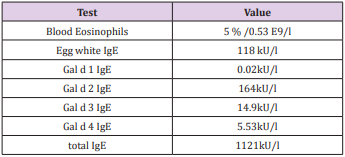Abstract
Background: Egg allergy is common in children. Most of the allergy outgrown with age. Oral food challenge (OFC) has been used in allergy diagnostics. Reference values within which 95% of the subjects with positive exposure-response to react, have been determined in many studies. Traditionally, the IgE level of total egg white antibodies has been used in the diagnostics. Sensitization to egg proteins, of which the heat stable Gal d 1 is the most important, can be studied by component diagnostics. Sampson egg white IgE 7 and our study Palosuo 13.3 kU/L. We present a patient with a very high egg white IgE level but a negative ovomucoid IgE level.
Case Presentation: A 20-month-old boy with atopic dermatitis and food allergy was send to allergic center. Milk and egg had been eliminated from the diet. The egg white IgE was high 118kU/l, but the heat stable egg protein Gal d 1-IgE (ovomucoid) 0.02kU/l was negative instead. There were no signs of symptoms in OFC of boiled egg with a cumulative dose of 875mg of egg white protein (around ¼ of a whole egg).
Conclusion: Allergen component diagnostics add value to the diagnostics of egg allergy compared to the only total egg white IgE and they should be controlled together in a patient with suspicious of egg allergy.
Keywords: Egg allergy; Allergen component; Molecular allergy diagnostics; IgE; Ovomucoid; Gal d 1
Clinical Report
Background
Hen’s egg allergy is one of the most common allergies in children with prevalence of max 2,5 % of children [1]. The prognosis of outgrowth is excellent [1] and many children with egg allergy can tolerate boiled egg [2]. Allergen specific IgE predicts the probability of developing a reaction and can help to decide whether an oral food challenge should be performed [3]. Many studies have been determined to make 95% predictive decision points that vary in different populations [3]. The allergen characterized in egg white include Gal d 1 (ovomucoid), Gal d 2(ovalbumin), Gal d 3 (conalbumin and Gal d 4 (lysozyme) [4]. Gal d 1 remains soluble after heating, as Gal d 2, 3 and 4 are unstable proteins and heating and enzymatic digestion reduces their allergenicity [4,5]. We describe a patient with very high level of egg white IgE, and ovalbumin IgE but negative ovomucoid IgE. The patient passed an oral food challenge with a cumulative dose of 875 mg of egg white protein.
Case Presentation
A 20-month-old child who was born full term by a cesarean section. The father of the child has atopic dermatitis and early childhood food allergies that outgrew with age. The mother had no history of atopy. The child developed severe atopic dermatitis beginning at the age of three months, which led to monitoring the child in the pediatric unit. The mother breastfed the child for 15 months and removed milk and eggs from her diet after which the condition of the skin seemed to improve. Finally, a calcineurin inhibitor treatment was started for atopic dermatitis after which the condition of the skin has remained good. At three months old, the laboratory findings were the following: egg white IgE was 51kU/l, milk IgE was 51kU/l, wheat IgE was 0.40kU/l. An accidental exposure to milk resulted in an urticarial reaction and vomiting. It was documented that the child didn’t receive any egg. In laboratory testing, that the child underwent at the age of 20 months, the findings were for milk and egg (Table 1). The total egg white antibodies were very high, but the Gal d 1-antibodies (ovomucoid) were negative. An open 4-step food oral challenge with boiled hen’s egg with a cumulative dose of 875 mg egg white protein was performed in the patient. The exposure did not cause any symptoms and the child was in good condition after monitoring at discharge. If egg white IgE results alone had been used, would the exposure most likely have been left undone. Ovomucoid IgE added significant value to the case.
Conclusion
Component-resolved diagnostics add value in relation to the total antibody level in the study of egg allergy. It is possible that the patient can tolerate boiled egg in spite of a very high antibody level. In the case in question, the probability of allergy was extremely high based on the egg white antibodies. However, ovomucoid IgE was low, which predicted tolerance to cooked egg. The patient was advised to avoid raw egg but introduce heated egg into the diet.
Acknowledgments of Funding
Jalmari and Rauha Ahokas foundation has supported the writing process. The corresponding author had final responsibility for the decision to submit for publication.
References
- Nwaru BI, Hickstein L, Panesar SS, Roberts G, Muraro A, et al. (2014) Prevalence of common food allergies in Europe: a systematic review and meta-analysis. Allergy 69(8): 992-1007.
- Clark A, Islam S, King Y, Deighton J, Szun S, et al. (2011) A longitudinal study of resolution of allergy to well-cooked and uncooked egg. Clin Exp Allergy 41(5): 706-712.
- Calvani M, Arasi S, Bianchi A, Caimmi D, Cuomo B, et al. (2015) Is it possible to make a diagnosis of raw, heated, and baked egg allergy in children using cutoffs? A systematic review. Pediatr Allergy Immunol 26: 509-521.
- Palosuo K, Kukkonen AK, Pelkonen AS, Mäkelä MJ (2018) Gal d 1-specific IgE predicts allergy to heated egg in Finnish children. Pediatr Allergy Immunol 29(6): 637-643.
- Sampson HA (2001) Utility of food-specific IgE concentrations in predicting symptomatic food allergy. J Allergy Clin Immunol 107(5): 891-896.

 Case Report
Case Report









